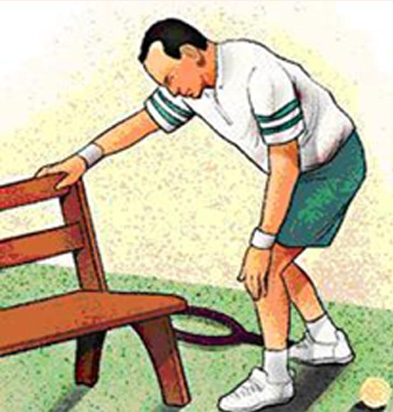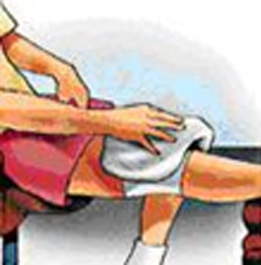-
Mon - Sat
08:00am - 08:00pm

If you have persistent pain, clicking, catching, locking , swelling or giving way in your knee, a procedure known as arthroscopy may help relieve these problems.
Arthroscopy allows an orthopaedic surgeon to diagnose and treat knee disorders by achieving a clear view of the inside of the knee with small incisions, using a pencil-sized instrument called an arthroscope. The scope allows transmission of an image of your knee through a small camera to a television monitor. The image allows the surgeon to thoroughly examine the interior of the knee and determine the source of the problem. During the procedure, the surgeon may take help of some small surgical instruments through other small incisions in your knee to asses, remove or repair damaged tissues.
With improvements of arthroscopes and higher resolution cameras, the procedure has become highly effective for both the accurate diagnosis and proper treatment of knee problems. The procedure is done now as day care where you are in hospital only for few hours.
Normally, all parts of the knee work together in harmony. Sports, work injuries, arthritis, or weakening of the tissues with age can cause wear and inflammation, resulting in pain and diminished knee function.
Arthroscopy can be used to diagnose and treat many of these problems:
Problems in the knee joint that usually can be seen and tackled with an arthroscope

Problems in the knee joint that usually can be seen with an arthroscope.
By providing a clear picture of the knee, arthroscopy can also help the orthopaedic surgeon decide whether other types of reconstructive surgery would be beneficial.

Signs that you may be a candidate for this procedure include swelling, persistent pain, catching, giving way, instability and loss of confidence in your knee. When other treatments, such as the regular use of medications, knee supports, and physical therapy, have provided minimal or no improvement, you may benefit from arthroscopy.
Orthopaedic surgeon at A+OSM will review the results of your evaluation with you and discuss the best methods to further diagnose your knee problem. Other diagnostic tests may be indicated, such as magnetic resonance imaging (MRI).
Treatment options include medications or surgical procedures, such as arthroscopy.
Orthopaedic surgeon at A+OSM Center will explain the the benefits and what can be expected out come of the procedure. Also brief you of potential risks.
If arthroscopy is indicated, you may be asked to have a complete physical examination with your family physician before surgery. This will assess your health and rule out any conditions that could interfere with your surgery.
Before surgery, tell orthopaedic surgeon at A+OSM Center about any medications or supplements that you are taking. You will be informed which medications you should stop taking before surgery.
Tests, such as blood samples or a cardiogram, may be ordered by orthopaedic surgeon to help plan your procedure and a routine check-up with anaesthetist is also undertaken.
Almost all arthroscopic knee surgery are done on an outpatient basis for healthy patients. Usually, you will be asked to arrive at the hospital an hour or two prior to your surgery. Do not eat or drink anything after midnight the night before your surgery.
After arrival, you will be evaluated by a member of the anesthesia team. Arthroscopy can be performed under local, regional, or general anesthesia.
If you have local or regional anesthesia, you may be able to watch the procedure on a monitor, if you wish.
The surgeon will then introduce the arthroscope to properly diagnose your problem, using the image projected on a monitor to guide the arthroscope.
This part of the procedure usually lasts 45 minutes to 1 1/2 hours.
Common treatments with knee arthroscopy include:
At the conclusion of your surgery, the surgeon may close your incisions with a suture or paper tape and cover them with a bandage.
You will be moved to the recovery room. Usually, you will be ready to go by evening or next day morning. You should have someone with you to drive you home.
Recovery from knee arthroscopy is much faster than recovery from traditional open knee surgery. Still, it is important to follow orthopaedic surgeon’s instructions carefully after you return home. You should ask someone to check on you that evening.

Dressing Care
You will leave the hospital with a dressing covering your knee. This will be changed after 48 hours and a small bandaid/water proof dressing is left. You may shower, but should avoid directing water at the incisions. Do not soak in a tub. Keep your incisions clean and dry.
Orthopaedic surgeon will see you in the office a few days after surgery to check your progress, review the surgical findings, and begin your postoperative treatment program.
Bearing Weight
After most arthroscopic surgeries, you can walk unassisted. Orthopaedic surgeon may advise you to use crutches, a cane, or a walker for a period of time after surgery depending on extent of surgery done. You can gradually put more weight on your leg as your discomfort subsides and you regain strength in your knee. Your surgeon may allow you to drive after a week.
Exercises to Strengthen Your Knee

You should exercise your knee regularly for several weeks following surgery to strengthen the muscles of your leg and knee. A physical therapist may help you with your exercise program if orthopaedic surgeon recommends specific exercises.
Medications
Orthopaedic surgeon may prescribe antibiotics to help prevent an infection and pain medication to help relieve discomfort for few days following your surgery.
Although arthroscopy can be used to treat many problems, you may have some activity limitations even after recovery. The outcome of your surgery will often be determined by the degree of injury or damage found in your knee. For example, if you damage your knee from jogging and the smooth articular cushion of the weight bearing portion of the knee has worn away completely, then full recovery may not be possible. You may be advised to find a low-impact alternative form of exercise.
An college level or professional athlete often sustains the same injury as a weekend recreational athlete, but the potential for recovery may be improved by the overall development of knee muscles.
Physical exercise and rehabilitation will play an important role in your final outcome. A formal physical therapy program also may add a lot to your final result.
A return to intense physical activity should only be done under the direction of your surgeon.
It is reasonable to expect that by six to eight weeks you should be able to engage in most of your former physical activities as long as they do not involve significant weightbearing impact. Twisting maneuvers may have to be avoided for a longer time.
If your job involves heavy work, such as a construction laborer, you may require more time to return to your job than if you have a sedentary job.
Regular exercise to restore your knee mobility and strength is necessary. For the most part, this can be carried out at home.
Orthopaedic surgeon at A+OSM centre may recommend that you exercise approximately 15 to 20 minutes two or three times a day. You also may be advised to engage in a walking program.
Orthopaedic surgeon at A+OSM centre may suggest some of the following exercises. The following guide can help you better understand your exercise or activity program that may be supervised by a therapist at the direction of Orthopaedic surgeon.
As you increase the intensity of your exercise program, you may experience temporary set backs. If your knee swells or hurts after a particular exercise activity, you should lessen or stop the activity until you feel better.
You should Rest, Ice, Compress (with an elastic bandage), and Elevate your knee (R.I.C.E.). Contact Orthopaedic surgeon if the symptoms persist.
Advanced: Before starting, add weights to your ankle, starting with 1 pound of weight and building up to a maximum of 5 pounds of weight over 4 weeks.
Advanced: Before starting, add weights to your ankle, starting with 1 pound of weight and building up to a maximum of 5 pounds of weight over 4 weeks.
Terminal Knee Extension, Supine
Advanced: Before starting, add weights to your ankle, starting with 1 pound of weight and building up to a maximum of 5 pounds of weight over 4 weeks.
Straight Leg Raises
Advanced: Before starting, add weights to your ankle, starting with 1 pound of weight and building up to a maximum of 5 pounds of weight over 4 weeks.
If you do not feel this stretch, bend your hip a little more, and repeat.
No bouncing! Maintain a steady, prolonged stretch for the maximum benefit.
Exercise Bike
Increase the duration by one minute a day until you are pedaling 20 minutes a day.
Walking
An excellent physical exercise activity in the middle stages of your recovery from surgery (after 2 weeks).
Running
Running should be avoided until 6 to 8 weeks because of the impact and shock forces transmitted to your knee. Both walking and running activities should be gradually phased into your. Knee Arthroscopy If you have persistent pain, clicking, catching, locking, swelling or giving way in your knee, a procedure known as arthroscopy may help relieve these problems.
Arthroscopy allows an orthopaedic surgeon to diagnose and treat knee disorders by achieving a clear view of the inside of the knee with small incisions, using a pencil-sized instrument called an arthroscope. The scope allows transmission of an image of your knee through a small camera to a television monitor. The image allows the surgeon to thoroughly examine the interior of the knee and determine the source of the problem. During the procedure, the surgeon may take help of some small surgical instruments through other small incisions in your knee to asses, remove or repair damaged tissues.
With improvements of arthroscopes and higher resolution cameras, the procedure has become highly effective for both the accurate diagnosis and proper treatment of knee problems. The procedure is done now as day care where you are in hospital only for few hours.